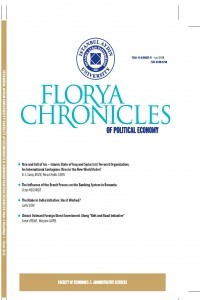The Make in India Initiative: Has it Worked?
The Make in India Initiative: Has it Worked?
Manufacturing sector has the potential to lift half a billion more of India’s
Keywords:
Make in India, manufacturing value added, factor markets, infrastructure regulatory bottlenecks,
___
- [1] With $2.3 trillion in GDP, India is the world’s ninth-largest economy and the third largest by purchasing power parity at $8 trillion (World Bank). [2] ILO (2016). ‘India Labor Market Update.’ ILO Country Office for India. [3] Dhawan, Rajat, Gautam Swaroop, and Adil Zainulbhai (2012). Fulfilling the promise of India’s manufacturing sector. McKinsey and Company. [4] Kaldor, N. 1967.Strategic Factors in Economic Development. Ithaca, NY: Cornell University. [5] Thirlwall A.P. 1983. A Plain Man’s Guide to Kaldor’s Growth Laws. Journal of Post Keynesian Economics 5: 345–358. [6] World Bank, Commission on Growth and Development. 2008. The growth report: strategies for sustained growth and inclusive development. [7] Dasgupta S. & Singh A. 2005. Will Services be the New Engine of Indian Economic Growth? Development and Change 36: 1035–57. [8] Wells H. & Thirlwall A.P. 2003. Testing Kaldor’s Growth Laws across the Countries of Africa. African Development Review 15: 89–105. [9] Szirmai, Adam and Bart Verspagen. 2015. “Manufacturing and Economic Growth in Developing Countries, 1950-2005.” Structural Change and Economic Dynamics 34: 46-59. [10] Chakravarty, S. and A. Mitra (2009), Is Industry still the engine of growth? An econometric study of the organized sector employment in India, Journal of Policy Modeling 31, 22-35. [11] Kathuria, Vinish and Rajesh R. Natarajan. 2013. “Is Manufacturing an Engine of Growth in India in the Post-Nineties?” Journal of South Asian Development 8(3): 385-408. [12] Baumol, William J. 1967. “Macroeconomics of Unbalanced Growth: The Anatomy of Urban Crisis.” American Economic Review 57 (3): 415–26. [13] Rodrik, Dani. 2016. “Premature Deindustrialization.” Journal of Economic Growth 21: 1–33. [14] OECD (2014a). Economic Survey of India. [15] Anand, Rahul, Kalpana Kochhar and Saurabh Mishra (2015), “Make in India: Which Exports Can Drive the Next Wave of Growth?” IMF Working Paper No. 15/119 [16] Excessive imports have affected Indian manufacturing for the last 12- 15 years. This is due to higher duties on intermediate goods compared to final finished goods, with the latter often enjoying concessional customs duty. This inverted duty structure has resulted in higher raw material cost at home. FICCI has pointed in a 2014 study the issue of inverted duties for sectors like aluminium, steel, chemicals, capital goods, electronics (Mehrotra, 2017). [17] Goldar, Bishwanath (2016). Manufacturing growth in India in recent years: Is it getting overstated in India’s new GDP series? Indian Growth and Development Review, 9 (2), 102-113. [18] In response to the difficulties faced by the SMEs and exporters, the Goods and Service Tax (GST) Council in October 2017 introduced measures to ease the compliance burden of SMEs and access to funding for exporters [19] FICCI and Konrad Adenauer Stiftung (2015). Skills development in India. [20] World Bank (2014). India development update. [21] Thomas et al. (2017). Taxation and investment in India. OECD Economics Department Working Papers, No. 1397. [22] OECD (2017). Economic Survey of India. [23] The minimum alternate tax (MAT) was estimated to claw back INR 360 billion in 2014-15, reducing the total revenue forgone to INR 624 billion. [24] OECD (2017). Economic Survey of India. [25] Ibid. [26] Peacock and Joseph (2017). Mixed messages to investors as India quietly terminates bilateral investment treaties with 58 countries. Herbert Smith Freehills Arbitration notes. [27] Ibid. [28] Datta, Pratik, Radhika Pandey and Sumant Prashant (2017). Replacing FIPB with Standard Operating Procedure not enough. https://ajayshahblog. blogspot.fr [29] OECD (2014b). Improving the business environment through effective regulation. OECD India Policy Brief. [30] Koske, I., I. Wanner, R. Bitetti and O. Barbiero (2015). The 2013 update of the OECD product market regulation indicators: policy insights for OECD and non-OECD countries. OECD Economics Department Working Papers, No. 1200. [31] Ahmed, S., S. Kelegama and E. Ghani (eds.) (2010). Promoting Economic Cooperation in South Asia. World Bank. [32] OECD (2015). The Participation of Developing Countries in Global Value Chains: Implications for Trade and Trade-Related Policies. [33] Ibid.
- ISSN: 2149-5750
- Yayın Aralığı: Yılda 2 Sayı
- Başlangıç: 2015
- Yayıncı: İstanbul Aydın Üniversitesi
